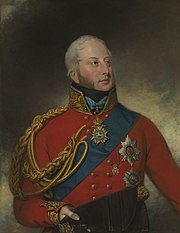| Prince William Frederick | |
|---|---|

| |
| Preceded by | Prince William Henry |
| Personal details | |
| Born | 15 January 1776 Teodoli Palace, Rome, Papal States |
| Died | 30 November 1834 (aged 58) Bagshot Park, Surrey, England |
| Spouse(s) | Princess Mary of the United Kingdom |
Prince William Frederick, Duke of Gloucester and Edinburgh, KG GCB GCH PC FRS (15 January 1776 – 30 November 1834) was a great-grandson of King George II and nephew and son-in-law of King George III of the United Kingdom.
Early life[]

The Duke of Gloucester, in an engraving based on a portrait painted by Sir William Beechey, published 1826.
Prince William was born on 15 January 1776 at Palazzo Teodoli in via del Corso, Rome.[1] His father was Prince William, Duke of Gloucester and Edinburgh, the third son of the Prince of Wales. His mother was Maria, Duchess of Gloucester and Edinburgh, the illegitimate daughter of Edward Walpole and granddaughter of Robert Walpole. As a great-grandson of George II he held the title of Prince of Great Britain with the style His Highness, not His Royal Highness, at birth. The young prince was baptized at Teodoli Palace, on 12 February 1776 by a Rev Salter. His godparents were the Duke and Duchess of Saxe-Gotha-Altenburg (his first cousin once-removed and his wife) and the Margrave of Brandenburg-Ansbach (his second cousin once-removed).[2]
During his stay in Stockholm in 1802–1803, his interest and rumoured affair with Aurora Wilhelmina Koskull attracted a lot of attention, and he reportedly had plans to marry her. Queen Charlotte recalled that William said of Koskull: "If she was your daughter, I would marry her!"[3]
He was admitted to the University of Cambridge (Trinity College) in 1787, and granted his MA in 1790.[4] On 25 August 1805, Prince William's father died, and he inherited the titles Duke of Gloucester and Edinburgh and Earl of Connaught. From 1811 until his death he was Chancellor of the University of Cambridge.[4] He was offered the position of king of Sweden in 1812 by some members of the Swedish nobility, but the British government would not allow it.
Marriage[]
On 22 July 1816, he married Princess Mary, his cousin and the fourth daughter of George III. The marriage took place at St. James's Palace, London. On that day, The Prince Regent granted the Duke the style of His Royal Highness by Order in Council.[5]
The Duke and Duchess of Gloucester lived at Bagshot Park in Surrey. They had no children together; they had married when both were 40. The Duke had been encouraged to stay single, so that there might be a suitable groom for Princess Charlotte of Wales, the heiress to the throne, even if no foreign match proved suitable; she had married Prince Leopold of Saxe-Coburg ten weeks earlier.[6]
Later life[]
He was active in many walks of life, and on 27 April 1822 chaired the first Annual General Meeting of London's new United University Club.[7] Politics, however, was not among them; he entered the House of Lords rarely, and he voted on few of the great issues of his time. He did advocate the abolition of slavery, and he supported Caroline of Brunswick and the Duke of Sussex against George IV.[8]
He kept more state than the King; he never permitted a gentleman to be seated in his presence (which King George did as an exceptional favour) and expected to be served coffee by the ladies of any party he attended, and that they would stand while he drank it.[9] The general estimate of his capacity is given by his nickname, "Silly Billy"; he was also called "Slice of Gloucester" and "Cheese",[8] a reference to Gloucester cheese.
The Duke died on 30 November 1834, and was buried in St. George's Chapel, Windsor.
Honours[]
- KG: Knight of the Garter, 16 July 1794[10]
- GCB: Knight Grand Cross of the Bath[citation needed]
- GCH: Knight Grand Cross of the Royal Guelphic Order[citation needed]
- PC: Lord of His Majesty's Most Honourable Privy Council[citation needed]
- FRS: Fellow of the Royal Society[citation needed]
Arms[]

Arms of Prince William Frederick
William was granted use of his father's arms (being the arms of the kingdom, differenced by a label argent of five points, the centre bearing a fleur-de-lys azure, the other points each bearing a cross gules), the whole differenced by a label argent (or azure).[11]
References[]
- ↑ "...the insignificant palaces, Fiano, Verospi, and Teodoli..." (Augustus Hare, Walks in Rome vol. i, 1903 p. 46).
- ↑ Yvonne's Royalty Home Page: Royal Christenings. Users.uniserve.com. Retrieved on 2012-07-15.
- ↑ Cecilia af Klercker (1927) (in Swedish). Hedvig Elisabeth Charlottas dagbok VII 1800–1806 (The diaries of Hedvig Elizabeth Charlotte VII 1800–1806). P.A. Norstedt & Söners förlag. OCLC 68029346.
- ↑ 4.0 4.1 "Gloucester, H.R.H. Prince William Frederick, Duke of (GLCR787WF)". A Cambridge Alumni Database. University of Cambridge. http://venn.lib.cam.ac.uk/cgi-bin/search.pl?sur=&suro=c&fir=&firo=c&cit=&cito=c&c=all&tex=%22GLCR787WF%22&sye=&eye=&col=all&maxcount=50.
- ↑ Royal Styles and Titles – 1816 Royal Warrant. Heraldica.org. Retrieved on 2012-07-15.
- ↑ Complete Peerage, "Duke of Gloucester", citing the obituary of Princess Mary in the Annual Register of 1857.
- ↑ Club History Since 1821 Archived 31 December 2007 at the Wayback Machine. at oxfordandcambridgeclub.co.uk (accessed 9 January 2008)
- ↑ 8.0 8.1 A. W. Purdue, ‘William Frederick, Prince, second duke of Gloucester and Edinburgh (1776–1834)’, Oxford Dictionary of National Biography, Oxford University Press, September 2004; online edn, May 2009.
- ↑ Complete Peerage, "Duke of Gloucester"
- ↑ The Peerage — William Frederick Hanover, 2nd Duke of Gloucester. Thepeerage.com. Retrieved on 2012-07-15.
- ↑ Marks of Cadency in the British Royal Family. Heraldica.org. Retrieved on 2012-07-15.
The original article can be found at Prince William Frederick, Duke of Gloucester and Edinburgh and the edit history here.